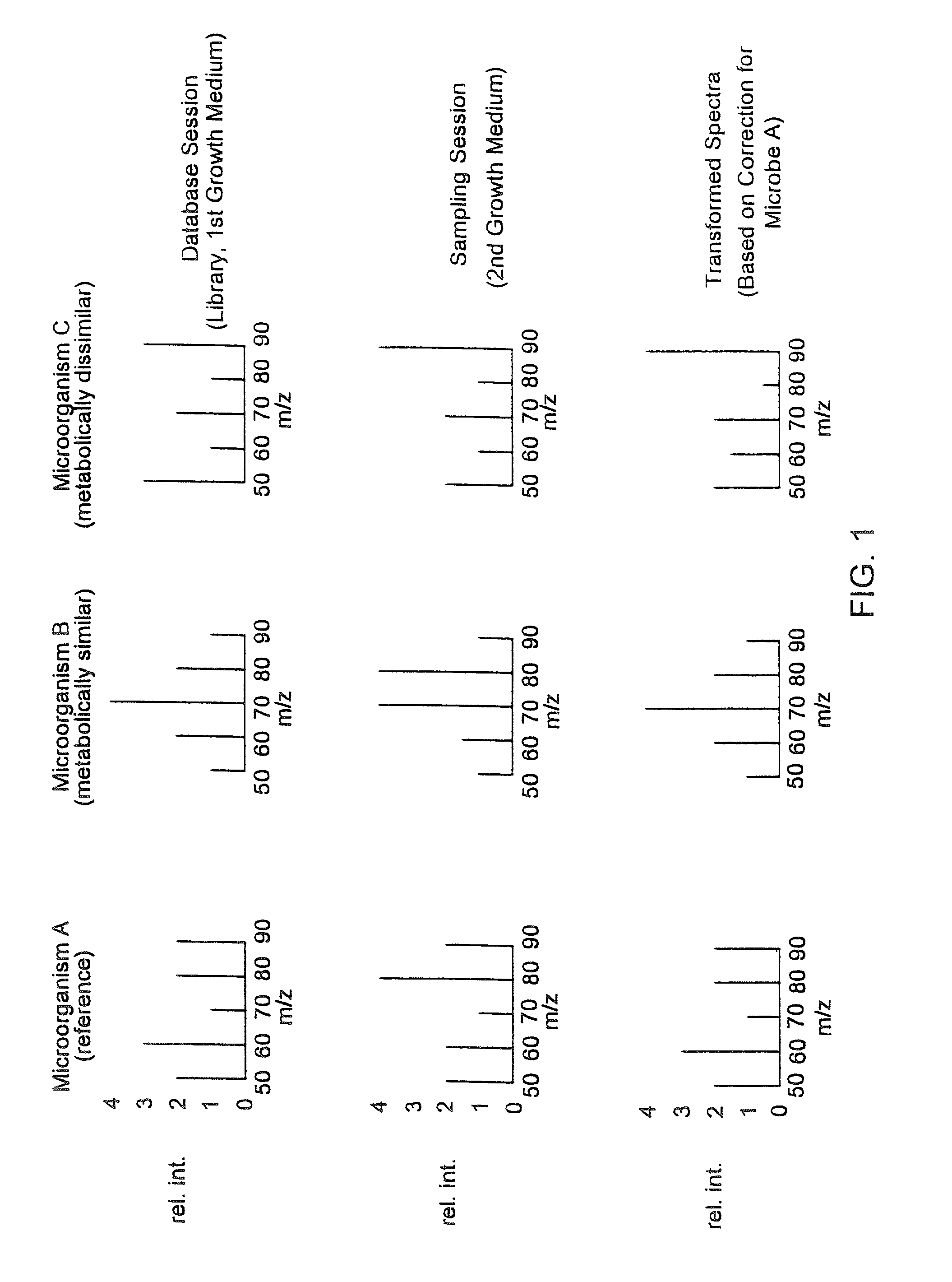Drift compensation method for fingerprint spectra
a fingerprint mass spectrum and drift compensation technology, applied in chemical methods analysis, instruments, material analysis, etc., can solve the problems of affecting the identification of microorganisms, etc., and achieve the goal of identifying microorganisms based on fingerprint mass spectrum, classification or identification of microorganisms
- Summary
- Abstract
- Description
- Claims
- Application Information
AI Technical Summary
Benefits of technology
Problems solved by technology
Method used
Image
Examples
example 1
Database Construction and Consultation for Microbial Identification
[0068]In its various embodiments, the methods presented herein may be utilized for both assembling a coherent database of fingerprint spectra for known microorganisms and consulting such databases for identification and classification of unknown microorganisms. Assembly and consultation of such databases may be automated using a computer implemented software program.
A. Assembly of a Coherent Database
[0069]A library database of fingerprint spectra for the identification or taxonomic classification of microorganisms may be compiled using fingerprint spectra (e.g. pyrolysis mass spectra) for microorganisms grown on a non-selective growth medium such as Tryptic Soy Agar (TSA). Other examples of non-selective growth media are Luria-Bertani and blood agar. A non-selective growth medium such as TSA, that supports the growth of numerous types of microorganisms, may be utilized during construction of a library database that i...
example 2
Transformation of Fingerprint Spectra to Correct for Changes in Growth Conditions
[0092]A particular embodiment of the disclosed methods is illustrated schematically in FIG. 1. Shown in the top row of FIG. 1 (database session) are three hypothetical mass spectra, one for each of three microorganisms, A, B, and C. These fingerprint spectra might, for example, represent fingerprint spectra obtained for these microorganisms under standardized conditions (e.g. grown on the same non-selective growth medium) and used as library database fingerprint spectra for the identification of these microorganisms. In the middle row (sampling session) are three hypothetical mass spectra that represent fingerprint spectra obtained for the same three microorganisms, but from a different environment (for example, grown on a different growth medium, such as a selective growth medium). These fingerprint spectra could, for example, represent the fingerprint spectra obtained for microorganisms grown on selec...
example 3
Identification of Microorganisms in Non-Cultured Samples
[0100]In another aspect of the disclosed methods, a microorganism of interest may be identified by its fingerprint spectrum regardless of whether it is cultured following isolation from the environment where it is found. Applying the environmental and instrumental drift compensation methods of the disclosure, identification of an unknown microorganism may be possible in as little as about one-half of an hour following its isolation. For example, microorganisms may be selectively extracted from biological fluids (e.g. urine, blood, feces, and spinal fluid) using immuno-affinity techniques and electrophoretic techniques, or impacted from aerosols, and analyzed directly to provide a fingerprint spectrum. The fingerprint spectrum may then be environmentally compensated according to the disclosed methods to provide an expected fingerprint spectrum for the microorganism in a standard database environment that may be compared to finge...
PUM
| Property | Measurement | Unit |
|---|---|---|
| current | aaaaa | aaaaa |
| thickness | aaaaa | aaaaa |
| thickness | aaaaa | aaaaa |
Abstract
Description
Claims
Application Information
 Login to View More
Login to View More - R&D
- Intellectual Property
- Life Sciences
- Materials
- Tech Scout
- Unparalleled Data Quality
- Higher Quality Content
- 60% Fewer Hallucinations
Browse by: Latest US Patents, China's latest patents, Technical Efficacy Thesaurus, Application Domain, Technology Topic, Popular Technical Reports.
© 2025 PatSnap. All rights reserved.Legal|Privacy policy|Modern Slavery Act Transparency Statement|Sitemap|About US| Contact US: help@patsnap.com



